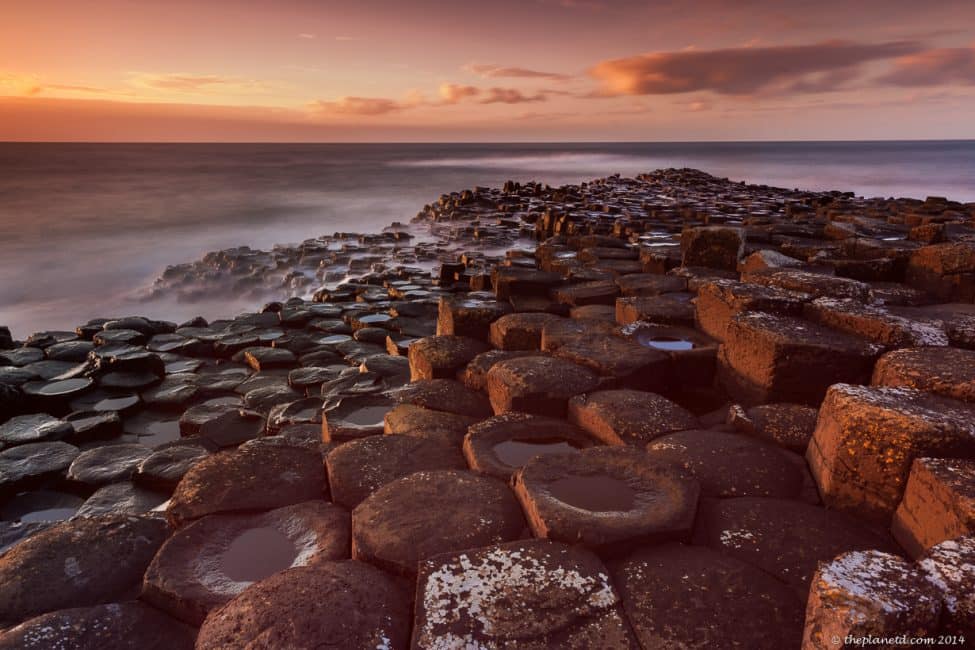Giant’s Causeway: Myths, Legends, and Visiting Tips
Science tells us that the Giant’s Causeway on the coast of Northern Ireland was formed by a volcanic eruption 60 million years ago. However, there is a legend of the Giant’s Causeway that is far more intriguing. When you witness it firsthand, it’s challenging to accept that Mother Nature alone created this masterpiece.
A UNESCO World Heritage Site, the Giant’s Causeway stands as Northern Ireland’s premier tourist attraction. Nestled in a stunning setting in County Antrim along the Causeway Coast, it represents one of the most unique landscapes we’ve ever explored!
The Giant’s Causeway – The Myths and Legends of Northern Ireland
As mentioned, a volcanic eruption created the basalt pillars of the causeway 60 million years ago. When the molten lava met the cool sea, it transformed into symmetrical hexagonal pillars stacked one upon the other.
Upon our first encounter with the Giant’s Causeway, we found the scientific explanations almost unbelievable. It appears too perfect.
The way the hexagonal tubes are arranged almost looks like an intricately designed interlocking brick pathway. Lava, after all, can’t flow that perfectly, can it?
It is said that there are over 40,000 basalt columns formed by the cooling of lava that collided with crashing waves of the ocean. While this is the scientific perspective, we naturally lean towards the captivating legend of the Giant’s Causeway and a giant named Finn McCool.
Giant’s Causeway Myths and Legends
Instead of solely relying on scientific reasoning, we chose to embrace the legend of Finn McCool (also known as Fionn Mac Cumhaill) and the mysteries surrounding the Giant’s Causeway. (After all, it was either that or alien intervention)
Standing on the Giant’s Causeway and examining the pillars ignites the imagination, making it easy to believe that this site was crafted by giants themselves. The formations appear to have been deliberately arranged by an extraordinary force.
The Story of Finn McCool and Scottish Giant Bennandoner
For generations, the tale of Finn McCool has been recounted across Ireland. People have long believed that the causeway was the work of giants. When you observe it closely, it’s easy to understand why.
One can easily envision a family of giants constructing this interlocking brick pathway to forge a connection between Northern Ireland and Scotland. (I often ponder if they quarreled as much as Dave and I did when arranging our patio stones at the front yard.)
According to legend, rivals Fionn Mac Cumhaill from County Antrim and the Scottish Giant Bennandoner frequently argued from afar. One fateful day, Finn McCool resolved to build a bridge that crossed the sea to confront Bennandoner.
He hurried across the causeway from Ireland to Scotland to surprise Bennandoner, but upon closer inspection, he realized that the giant was much larger than he had anticipated. In a panic, McCool turned on his heels and sprinted back to Antrim. Bennandoner, noticing McCool’s retreat, decided to follow him back.
Being clever, the Irish giant Finn McCool sought his wife’s assistance. (As many women can attest, this is often what husbands do!) He explained that he had been challenged to a fight by the much larger Bennandoner. What could he possibly do?
She quickly devised a plan, dressed him in a bonnet and shawl to disguise him as a baby, and placed him in a crib. When Bennandoner spotted the giant baby, he assumed that a fully grown giant would be far too intimidating to engage in battle, prompting him to retreat to Scotland, destroying the causeway while making his escape. Though the bridge was gone, remnants of it still endure.
Giant’s Causeway Today
Watch the captivating video of the Myth of Finn McCool at the Giant’s Causeway visitor’s center.
While strolling along the approximately 40,000 pillars that remain of the Giant’s Causeway, it’s easy to visualize these stone formations as steps leading out over the sea. Their flawless structure and exquisite craftsmanship make it difficult not to indulge in the legend. We could effortlessly imagine a bridge spanning the water.
Fingal’s Cave
Hearing of similar basalt pillars at Fingal’s Cave on Scotland’s Isle of Staffa only strengthens the belief in the legend. Can you envision a splendid giant causeway connecting the two islands? And isn’t it delightful to entertain the notion of giants, even if just for a fleeting moment?
Visiting the Giant’s Causeway
The most rewarding way to experience the Giant’s Causeway is by embarking on a road trip along the Causeway Coast. Having the convenience of a car allowed us to explore all the popular sites in Northern Ireland without the usual crowds.
Tour buses start arriving around 10 am and continue to do so throughout the day.
We chose to stay at the Giant’s Causeway Hotel, allowing us to visit the causeway at both sunrise and sunset. During these magical moments, we encountered barely another soul. This accommodation granted us the chance to walk down to the causeway and soak in the picturesque views. During sunset, we shared the basalt columns with only two other visitors.
Be sure to explore the Giant’s Causeway visitor’s center to enhance your understanding of this magnificent site.
Are you a believer in legends, or do you prefer the scientific explanations?
For additional travel insights about Ireland, please visit GoToIrelandCA. For accommodation options at the Giant’s Causeway, check out the Causeway Hotel.




